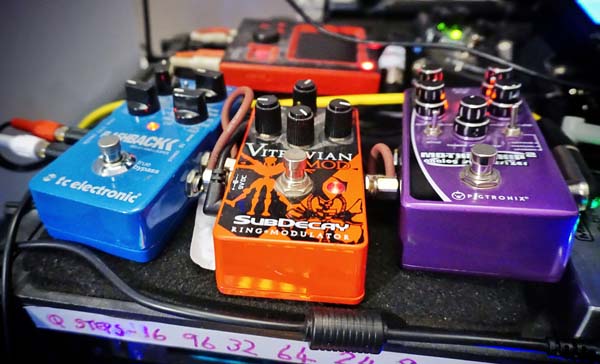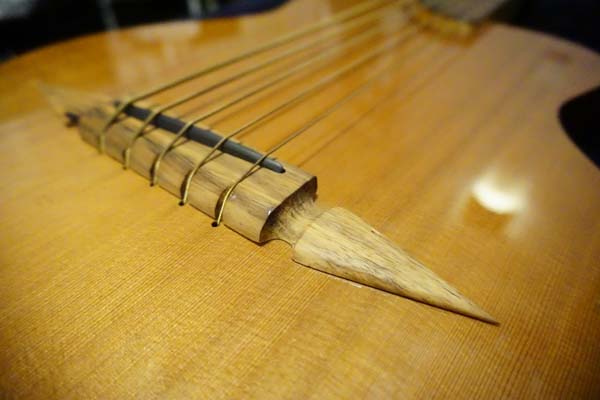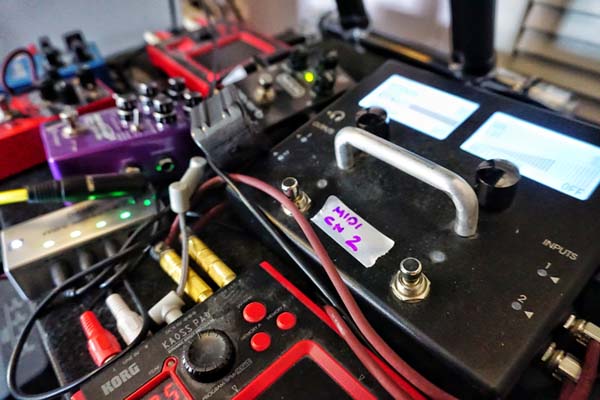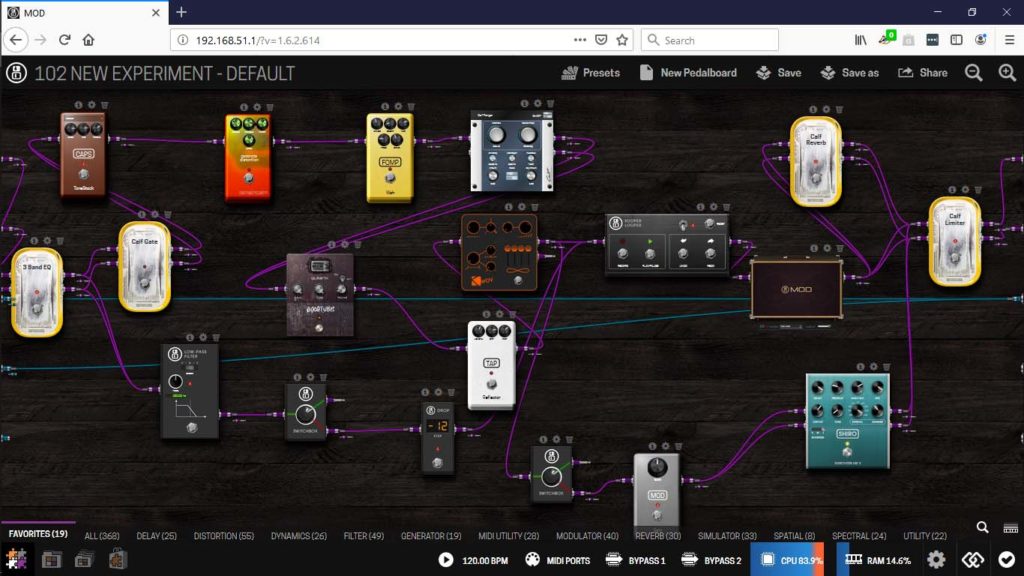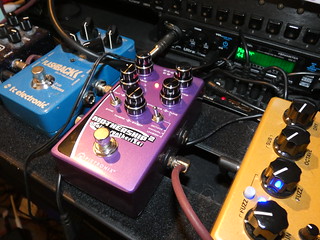You may have noticed that I tend to split my pedal board between the floor and the top of my rackcase. You may also wonder why I still have so many analog pedals when I also have the MOD Duo (written about here) which sound so incredible. So let’s have a look at what pedals offer.
I’ve said many times that I don’t think of my instrument as being a bass and all the rest of the stuff as being a way of processing the sound of the bass. My instrument starts at my fingertips and ends at the speakers. if I was being even more picky, I’d suggest that the acoustics in the room we’re in were part of it too. But I certainly view the entirety of my musical equipment as an instrument, comprised of many working parts. In the same way that a pianist doesn’t think of themselves as playing keys while the hammers are just an effect that changes the sound of the strings, with the wooden body being an amplifier, I don’t see any of the stuff that goes into making the sound as any more or less significant to the overall picture.
Which means that when it comes to thinking about the range of possibilities for an improvised performance, I want to be able to access as many possible combinations of sound from my instrument as possible. So I like to keep a bunch of my pedals at hand height in order to have all of the possible settings available to me, and also have the option to use them to change sounds as they are happening – hitting a sustained note and turning one of the many controls on the Pigtronix Mothership 2 synth pedal will offer all manner of bizarre and beautiful evolving, morphing sounds.
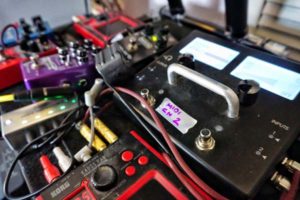 The MOD Duo is an absolutely exquisite sounding device, but the specific interface of each pedal reflects its performance possibilities – even down to how tricky it is to reach certain controls, or how sensitive they are. It would be possible to set up a bunch of that stuff as MIDI control on the Duo – and I have got LOADS of real time control over it, with the ability to stack multiple parameters on each of the two knobs, but having all those knobs AND all the controls on each pedal gives me a far far greater range of performance possibilities, and allows me to react to things in a more instantaneous and serendipitous way.
The MOD Duo is an absolutely exquisite sounding device, but the specific interface of each pedal reflects its performance possibilities – even down to how tricky it is to reach certain controls, or how sensitive they are. It would be possible to set up a bunch of that stuff as MIDI control on the Duo – and I have got LOADS of real time control over it, with the ability to stack multiple parameters on each of the two knobs, but having all those knobs AND all the controls on each pedal gives me a far far greater range of performance possibilities, and allows me to react to things in a more instantaneous and serendipitous way.
The degree to which I ‘learn’ what any pedal does depends on what I’m asking from it – when I have either the Aguilar Filter Twin, or MXR Bass Envelope Filter at hand height, I tend to have quite specific settings in mind, and move between those sounds I know to be what I’m looking for. Whereas the aforementioned Mothership 2, or the Subdecay Virtuvian MOD ring modulator are both pedals I can just set to random combinations and see what craziness happens. I was talking to Tim LeFebvre about the Mothership 2 recently, and he mentioned that he always turns the ‘glide’ control up – that’s a portamento function that makes the pitch of everything really slidey and imprecise. Which is exactly what a pedal like this does so well – the temporary ceding of some control to the whims of the pedal mean that your instrument becomes a partner that you’re now negotiating with over what the hell is going to happen next. This stuff isn’t just a tool box that you’re using, it’s a hostage situation and you’re trying to sweet talk your way out of the whole world of sounds caving in on you. 🙂
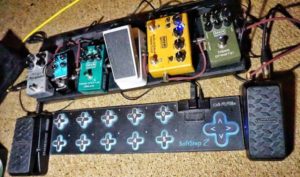 The number of pedals I have at hand height changes from month to month – at the moment I’m in a fairly settled phase with the Mothership 2, Vitruvian MOD, TC Electronic Flashback and then a Kaoss Pad mini KP… which is ALL about hand control. the touch interface is where all the magic happens, and the fact that the mini version allows very limited save and recall functions again makes it all the more interactive. I quite often just spin the dial and see what comes out, responding to whatever sound I land on and finding something new in it.
The number of pedals I have at hand height changes from month to month – at the moment I’m in a fairly settled phase with the Mothership 2, Vitruvian MOD, TC Electronic Flashback and then a Kaoss Pad mini KP… which is ALL about hand control. the touch interface is where all the magic happens, and the fact that the mini version allows very limited save and recall functions again makes it all the more interactive. I quite often just spin the dial and see what comes out, responding to whatever sound I land on and finding something new in it.
But there’s another great advantage to having pedals at hand height – the need to stop playing. There’s an age-old conversation that goes on between horn players and guitarists – the horn players are constantly trying to learn how to do long continuous melodic phrases like the guitar players, but learning circular breathing techniques, and the guitarists often end up on a journey towards learning to phrase lines in a way that breathes, that has natural pauses.
The interaction with pedals by hand leads you to such interesting and unexpected compromises between how to play the notes you want to have happen and how to make the sounds change and evolve in the you want. I’ve learned various quite specific techniques for combining sustained notes with altered pedal control, and I also use delays to set up extended phrases that I can then manipulate with whatever is downstream. Sometimes I have a looper right at the front of my signal chain so I can just focus on the pedal manipulation (and I have a 2nd mini Kaoss Pad after the aux out on my Looperlative looper so I can send anything that’s looped in there through the KP and manipulate that too, often at the same time as I’m trying to play bass, and percussion via the Quneo…)
All of these interactions are how I try to circumvent the possibility of mundane, predictable things happening. They give me a massive range of sonic choices, but also set up an enhanced likelihood of random, unexpected semi-chaotic music happenings that I’m then called on to rationalise and put in a context that makes sense of them. It’s that back and forth with my own playing that makes any performance a collaboration between the actual and the expected, between what’s there and what I imagine it can become… The whole thing is about the unfolding rather than just the execution of a preordained, precomposed thing. There is no ‘ideal’ version, no external reference for what is and isn’t the ‘right’ thing to do. There is only what’s happen and the range of possibilities for what can happen next, and manipulating pedals is a huge huge part of the expanded range of possibilities in the moment.
So, if you’re a musician who uses any kind of signal processing, have a think about how best to interact with it all, how you can make it do interesting things. Have a watch of the video for an older tune of mine, Vertigo, below and see if you can see exactly what’s happening with the Kaoss Pad and the pedals…

